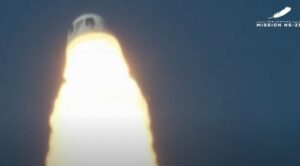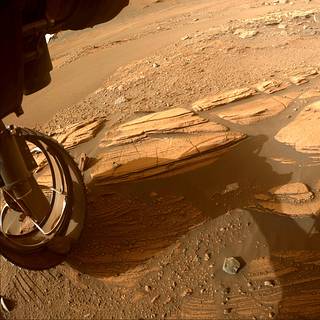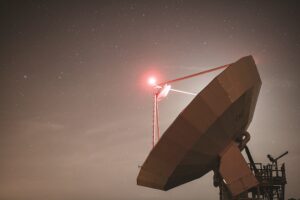Blue Origin rocket suffers booster failure, prompting emergency abort system
Monday, 12 September 2022 19:44 Blue Origin's New Shepard rocket suffered a booster failure after lifting off Monday morning, causing an emergency abort system to separate the capsule from the booster.
The unmanned mission was carrying 36 payloads from academia, research institutions, and students across the globe and was expected to reach the edge of space and return in a series of suborbital flights.
It was t
Blue Origin's New Shepard rocket suffered a booster failure after lifting off Monday morning, causing an emergency abort system to separate the capsule from the booster.
The unmanned mission was carrying 36 payloads from academia, research institutions, and students across the globe and was expected to reach the edge of space and return in a series of suborbital flights.
It was t SpaceX says likely won't need 42,000 satellites for Starlink internet
Monday, 12 September 2022 19:44 SpaceX, which has requested authorisation to deploy up to 42,000 satellites to provide its Starlink satellite internet service, probably won't need to launch that many into orbit, its chief operations officer said Monday.
Starlink - the satellite internet service of tech billionaire Elon Musk - offers high-speed broadband service to customers in areas that are poorly or not served by fixed
SpaceX, which has requested authorisation to deploy up to 42,000 satellites to provide its Starlink satellite internet service, probably won't need to launch that many into orbit, its chief operations officer said Monday.
Starlink - the satellite internet service of tech billionaire Elon Musk - offers high-speed broadband service to customers in areas that are poorly or not served by fixed Webb telescope captures 'breathtaking' images of Orion Nebula
Monday, 12 September 2022 18:04
The wall of dense gas and dust resembles a massive winged creature, its glowing maw lit by a bright star as it soars through cosmic filaments.
An international research team on Monday revealed the first images of the Orion Nebula captured with the James Webb Space Telescope, leaving astronomers "blown away."
The stellar nursery is situated in the constellation Orion, 1,350 light-years away from Earth, in a similar setting in which our own solar system was birthed more than 4.5 billion years ago.
Astronomers are interested in the region to better understand what happened during the first million years of our planetary evolution.
The images were obtained as part of the Early Release Science program and involved more than 100 scientists in 18 countries, with institutions including the French National Center for Scientific Research (CNRS), Western University in Canada, and the University of Michigan.
CHEOPS space telescope celebrates first thousand days in orbit
Monday, 12 September 2022 17:57
After 1,000 days in orbit around the Earth, the CHEOPS space telescope shows almost no signs of wear. Under these conditions, it could continue to reveal the fascinating details of many exoplanets for many years to come. CHEOPS is a joint mission of the European Space Agency (ESA) and Switzerland, led by the University of Bern (UNIBE) in collaboration with the University of Geneva (UNIGE).
Since its launch from Europe's Spaceport in French Guiana, on December 18, 2019, the CHEOPS telescope in Earth's orbit has demonstrated its functionality and precision beyond expectations. During this time, it has revealed the characteristics of numerous fascinating planets beyond our solar system (exoplanets) and has become a key instrument for astronomers in Europe and worldwide.
In over 1 million of minutes of observation time, CHEOPS has revealed exoplanets from every angle: their night sides when they pass in front of their stars, their day sides when they pass behind their stars and all the phases in between, just like the moon.
Eutelsat and OneWeb consider second-generation LEO plans
Monday, 12 September 2022 16:00
OneWeb is considering plans for a second-generation constellation jointly with Eutelsat ahead of closing their proposed merger, executives for the satellite operators said Sept. 12.
The post Eutelsat and OneWeb consider second-generation LEO plans appeared first on SpaceNews.
Six space companies join Techstars aerospace accelerator
Monday, 12 September 2022 15:00
Five space-related companies from the United States and one from the United Kingdom are joining the fall 2022 Techstars Aerospace and Defense Accelerator.
The post Six space companies join Techstars aerospace accelerator appeared first on SpaceNews.
Bezos rocket fails during liftoff, only experiments aboard
Monday, 12 September 2022 14:52
Jeff Bezos' rocket company suffered its first launch failure Monday.
Bezos rocket crashes after liftoff, only experiments aboard
Monday, 12 September 2022 14:52
Jeff Bezos' rocket company suffered its first launch failure Monday.
New Shepard suffers in-flight abort on uncrewed suborbital flight
Monday, 12 September 2022 14:18
A problem with Blue Origin’s New Shepard suborbital vehicle caused an in-flight flight a minute after liftoff Sept. 12, causing a capsule filled with payloads but not people to fire its launch abort motor and parachute to a safe landing.
NASA to Host Briefing on Perseverance Mars Rover Mission Operations
Monday, 12 September 2022 12:49 NASA will host a briefing at 11:30 a.m. EDT (8:30 a.m. PDT) on Thursday, Sept. 15, at the agency’s Jet Propulsion Laboratory in Southern California to provide highlights from the first year and a half of the Perseverance rover’s exploration of Mars.
NASA will host a briefing at 11:30 a.m. EDT (8:30 a.m. PDT) on Thursday, Sept. 15, at the agency’s Jet Propulsion Laboratory in Southern California to provide highlights from the first year and a half of the Perseverance rover’s exploration of Mars. Startups to test advanced computing technology on lunar missions
Monday, 12 September 2022 12:29
Like missions in low-Earth and geostationary orbit, deep space missions will require extensive computing capability.
The post Startups to test advanced computing technology on lunar missions appeared first on SpaceNews.
PCX Aerosystems Announces Acquisition of NuSpace
Monday, 12 September 2022 12:13 PCX Aerosystems ("PCX"), a market-leading producer of advanced mechanical systems for the aerospace industry, announced the September 2, 2022 acquisition of NuSpace, Inc. ("NuSpace") from Cornerstone Capital Holdings and members of the NuSpace leadership team. With engineering and manufacturing roots going back to 1907, NuSpace has evolved from a diversified mechanical systems manufacturer into
PCX Aerosystems ("PCX"), a market-leading producer of advanced mechanical systems for the aerospace industry, announced the September 2, 2022 acquisition of NuSpace, Inc. ("NuSpace") from Cornerstone Capital Holdings and members of the NuSpace leadership team. With engineering and manufacturing roots going back to 1907, NuSpace has evolved from a diversified mechanical systems manufacturer into Thales Alenia Space Partners With Kythera Space Solutions for Advanced Space Inspire Mission Segment Software
Monday, 12 September 2022 12:13 Kythera Space Solutions (Kythera), the leading provider of dynamic management systems for next-generation payloads and SATCOM networks, has entered into a 10-year partnership with Thales Alenia Space, a Joint Venture between Thales (67 %) and Leonardo (33 %), to develop the Ground Mission Segment System (GMSS) for Thales Alenia Space's software-defined satellite (SDS) product line, Space Inspire
Kythera Space Solutions (Kythera), the leading provider of dynamic management systems for next-generation payloads and SATCOM networks, has entered into a 10-year partnership with Thales Alenia Space, a Joint Venture between Thales (67 %) and Leonardo (33 %), to develop the Ground Mission Segment System (GMSS) for Thales Alenia Space's software-defined satellite (SDS) product line, Space Inspire A thousand days of CHEOPS
Monday, 12 September 2022 12:13 After a thousand days in orbit, the CHEOPS space telescope shows almost no signs of wear. Under these conditions, it could continue to reveal details of some of the most fascinating exoplanets for quite some time. CHEOPS is a joint mission by the European Space Agency (ESA) and Switzerland, under the aegis of the University of Bern in collaboration with the University of Geneva.
Since its
After a thousand days in orbit, the CHEOPS space telescope shows almost no signs of wear. Under these conditions, it could continue to reveal details of some of the most fascinating exoplanets for quite some time. CHEOPS is a joint mission by the European Space Agency (ESA) and Switzerland, under the aegis of the University of Bern in collaboration with the University of Geneva.
Since its Major operator consolidation is a long time coming
Monday, 12 September 2022 12:12
Mergers between even small operators have been few and far between in an industry where nationalistic protectionism and unique regulations often inhibit deal-making.
The post Major operator consolidation is a long time coming appeared first on SpaceNews.

